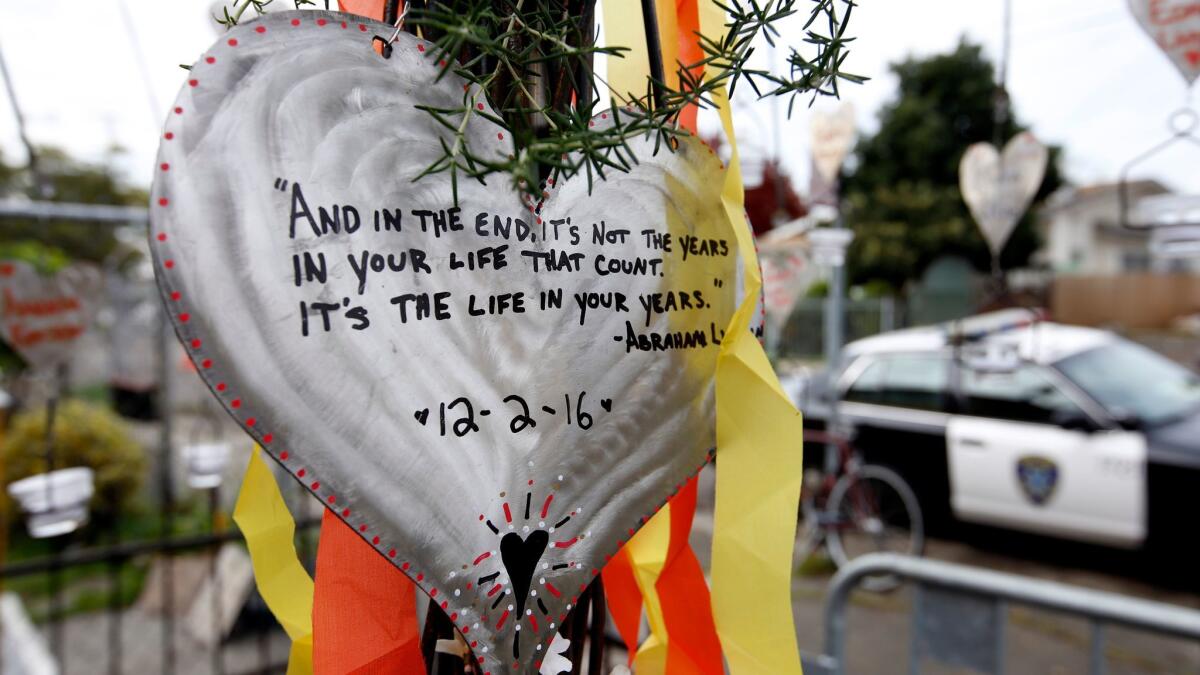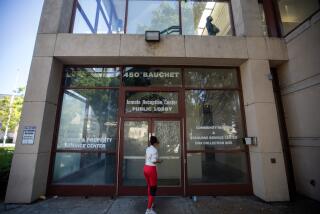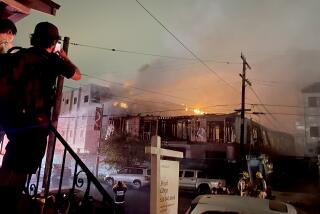Oakland officials well aware of problems at Ghost Ship before fire killed 36, records show

In the years leading up to a fire that killed 36 people inside an Oakland warehouse, city officials visited the building numerous times and investigated at least 10 code enforcement complaints, according to records released Wednesday by the city.
Despite mounting evidence that the warehouse had been converted into an illegal residence and music venue, the city never moved to shut down the Ghost Ship, the documents show. The city had received several complaints that the conditions inside the warehouse were unsafe, including reports of piles of trash and faulty electrical wiring.
The release of the records, requested by The Times and other media outlets, comes amid criticism of what many consider Oakland’s lax enforcement of conditions at the Ghost Ship and other converted warehouses around the city.
The warehouse caught fire Dec. 2 during a concert, trapping scores of people inside.
The records suggest that city officials should not have been surprised about illegal concerts occurring in the space.
In March 2015, an Oakland police officer responded to a report that alcohol and drugs were being sold at an illegal rave at the Ghost Ship. In his report, the officer said he did not enter the warehouse or issue any citations. Police were summoned back to the scene later after receiving a complaint from a caller that “there were several subjects inside his warehouse refusing to leave.”
Police stood by and waited for the subjects to leave, according to the report, which was heavily redacted.
Another description of the 2015 event was recorded in a transcript of a 911 call that was transferred from the California Highway Patrol. The caller said there were “15 people barricaded inside the business,” adding “the owners are holding people inside.” The caller also reported hearing what sounded like a Taser and threatening remarks.
Some family members of the victims as well as some Oakland officials said the records provided clear evidence of the city’s failure.
“I’m outraged. I’m outraged that nothing was done for all these years and this was allowed to happen. Put yourself in my shoes. What if it was your 20-year-old daughter, or your sister or your loved one,” said David Gregory of South San Francisco, whose daughter Michela died in the fire. “The more you learn about it, the more you realize that this shouldn’t have happened.”
Oakland City Councilman Noel Gallo, whose council district includes the area where the warehouse was located, said the documents highlight City Hall’s failure to response to longstanding neighborhood complaints about the Ghost Ship.
“The neighbors and the merchants who have lived in the area have certainly known the issue. … The city did not want to take responsibility or the liability,” Gallo said Wednesday . “It was known was beyond just one department. It wasn’t one time or two times that it was called in.”
The city was investigating an illegal housing complaint there just two weeks before the fire. A code inspector who went to the scene, however, said he could not gain entrance to the property or “see if there is an illegal building from the sidewalk.”
City files show he cited the building’s owner, Chor N. Ng, for the condition of the sidewalk and front yard.
It does not appear that city inspectors took stock of the conditions inside the warehouse until after the blaze, according to the records. Weeks after coroner’s officials removed the bodies from the building’s charred husk, code enforcement inspectors returned and issued new citations against Ng.
Ng was notified Dec. 22 of the need to remove debris and to repair walls, the roof and ceiling. She also was cited, for the first time, for “unapproved alterations” throughout the building.
“There are sleeping rooms created on the second floor as well as a kitchen,” the inspector wrote. “There are new partition walls, makeshift paint booth toilet stalls etc.,” he wrote.
The inspector also faulted the building for having “exposed and unsafe” wiring, fixtures, and electrical panels, records show.
Oakland officials released some records but withheld others that it considers relevant to the criminal investigation of the Dec. 2 fire, one of the worst in modern California history. The fire occurred during an illegal concert. Many of the files are heavily redacted.
The warehouse and an adjacent vacant lot have been the subject of 10 code enforcement complaints and 39 code enforcement inspections since 2004, city records show. Fire inspectors had also visited the building 16 times since 1999, most recently in 2016.
While city code enforcement inspectors never went inside the warehouse, records show they did talk to the “tenant” in 2014 as they tried to require Ng and her daughter to remove discarded furniture, pallets and other debris overflowing onto and blocking the sidewalk in front.
The city received an explicit complaint that the warehouse had been converted into an illegal residence in February 2015, police records show. According to a transcript of a 911 call claiming a man armed with a shotgun was hiding near the warehouse, a caller described the Ghost Ship as “a warehouse that is also an illegal shared housing.”
Shelley Mack, a former tenant who had a run-in with landlord Derick Ion Almena, said she was the woman who made that call. Mack said in an interview that the officer went inside and saw the deteriorating conditions at the warehouse, though the reports released on Wednesday do not confirm that.
“He came inside and saw everything,” she said Wednesday. “The officer that escorted my son and I out when I moved out a week or so later was told too. He was inside. They almost always came inside.”
Mack criticized Oakland police for failing to do more.
“They’re on the front line,” she said. “Why would all these dots not connect? There were a million dots.”
In releasing the documents, Mayor Libby Schaaf said she hoped they would help answer questions residents have posed about the city’s actions.
“I recognize the media and others have been frustrated by the time it has taken to assemble these documents from many different departments because we were determined to cast a wide net to provide all relevant information and take an exhaustive look at not just the warehouse, but also the immediately adjacent properties,” she said in a statement. “Transparency is critical. Our impacted community deserves to know all the facts about this tragedy.”
ALSO
The L.A. DIY community contemplates a post-Ghost Ship life
Oakland fire chief goes on leave two months after deadly Ghost Ship warehouse fire
UPDATES:
4:30 p.m.: This article was updated with comments from a victim’s family member and Oakland city officials, including Mayor Libby Schaaf.
2:40 p.m.: This post was updated with additional information from the records released by the city of Oakland.
This post was first published at 12 p.m.
More to Read
Sign up for Essential California
The most important California stories and recommendations in your inbox every morning.
You may occasionally receive promotional content from the Los Angeles Times.














